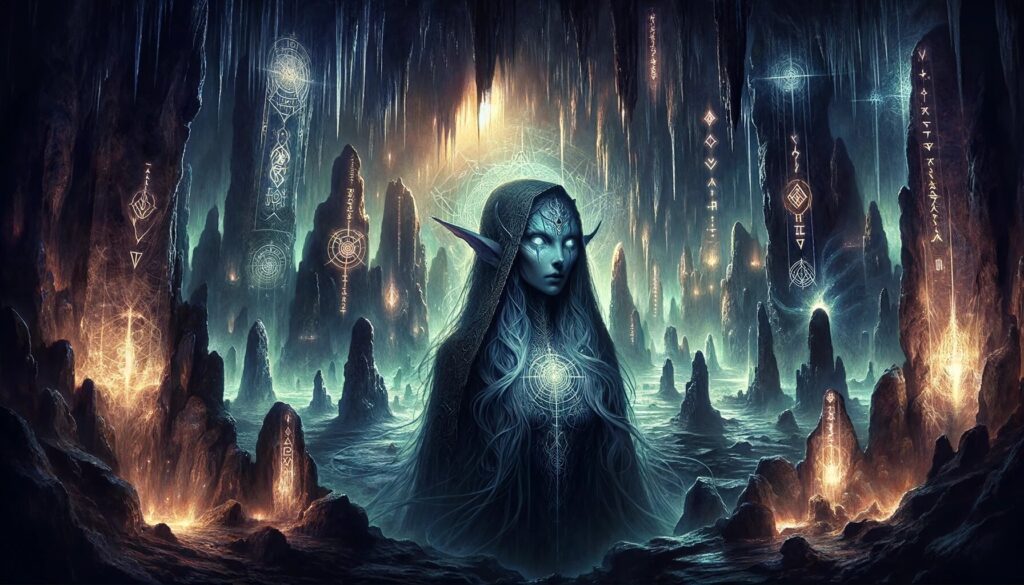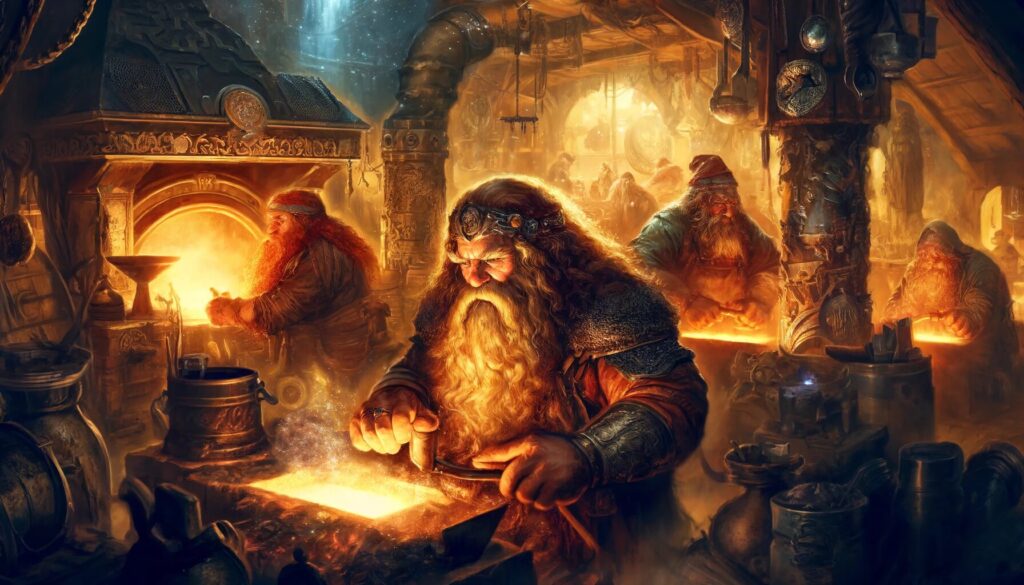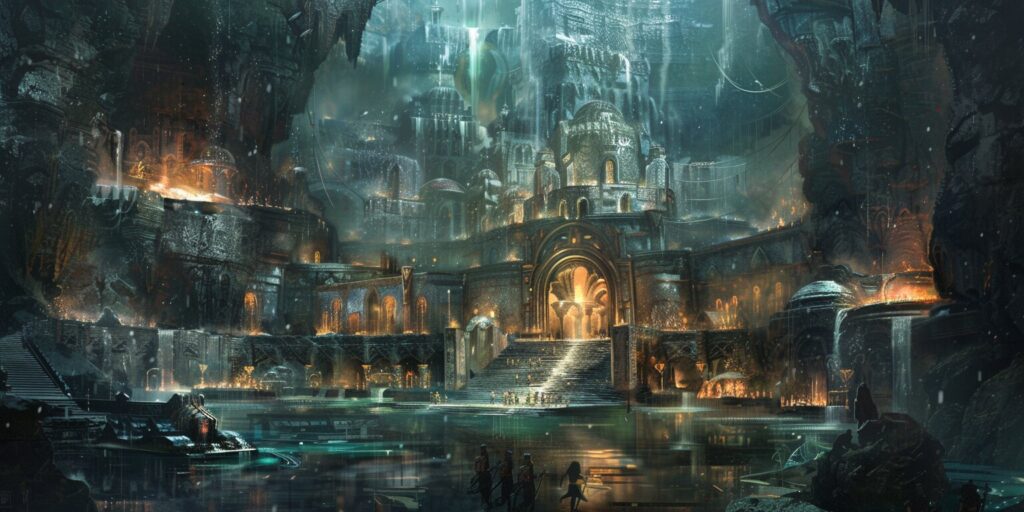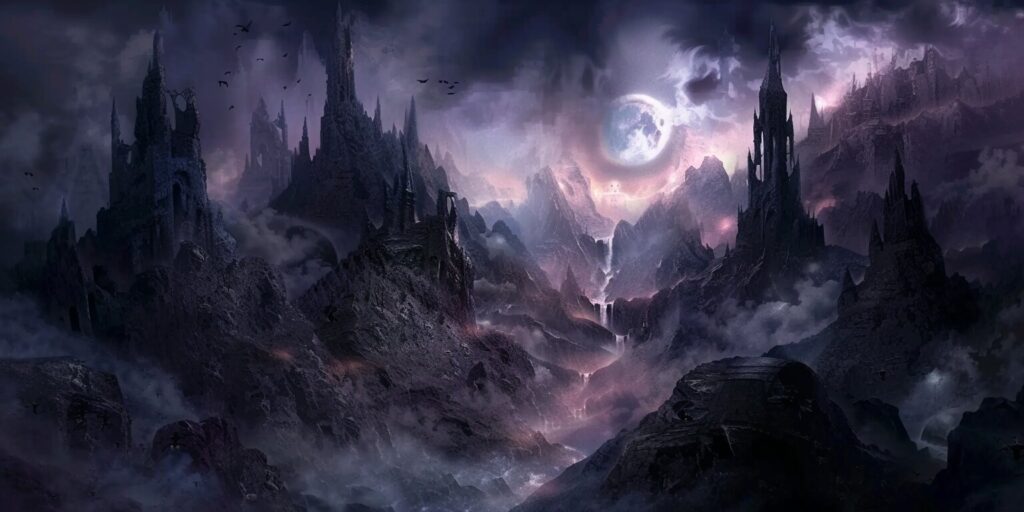Creatures in Norse mythology, Dwarves, Elves, Nidavellir (Svartalfheim), Norse Cosmology, Norse Mythology, The Nine Worlds
Exploring the Shadows: Svartalfheim and Nidavellir, the Dark Elves’ Domain
Welcome to an in-depth exploration of two intriguing realms in Norse mythology: Svartalfheim and Nidavellir. These mystical domains, associated with dark elves and dwarves, have captured people’s imaginations for centuries. Journey with us as we delve into the origins, lore, and significance of Svartalfheim in the Nine Realms. We will also unveil the distinctions between dark elves and dwarves and illuminate the mythical beings that inhabit Svartalfheim and Nidavellir.
Our exploration extends beyond myth and legend to uncover how these realms were woven into the tapestry of Viking Age beliefs. Discover their depictions in Norse sagas and their connections to key Norse figures. Furthermore, we will delve into ancient stories and texts, such as the Eddas and sagas, to unravel the interpretations of Svartalfheim and Nidavellir in Old Norse literature. By the end of this enchanting journey, you’ll gain a comprehensive understanding of these mysterious realms and their indispensable role in Norse mythology.
What is the Significance of Svartalfheim in Norse Mythology?
In Norse mythology, Svartalfheim holds great significance as the realm of the dark elves, known as svartálfar. This underground realm is shrouded in shadows and mystery, captivating the imaginations of those who delve into its lore. The origins of Svartalfheim, as one of the nine realms, are steeped in ancient tales recounting its creation and its intricate connections to other realms in the Nine Worlds.
Exploring the Origins and Lore of Svartalfheim
Svartalfheim is believed to be situated beneath the roots of Yggdrasil, the World Tree, with hidden passages connecting it to other realms. These hidden passages reveal the interconnectedness of the realms, including the dwarf realm of Norse mythology, further enriching the narrative tapestry of Norse mythology.
The realm itself is characterized by exceptional craftsmanship and master builders – the dark elves. These skilled artisans create exquisite works of art, weapons, and jewelry. Their craftsmanship is widely revered among the Norse gods and mortals, making Svartalfheim a hub of creativity and ingenuity.

The Role of Svartalfheim in the Nine Realms
Within the cosmology of Norse mythology, Svartalfheim or Nidavellir plays a pivotal role in showcasing the contributions of the different realms to the overall framework. It demonstrates the interconnectedness of the Nine Realms, including Svartalfheim as one of the nine, and highlights each realm’s unique qualities and skills.
As the realm of the dark elves, Svartalfheim brings forth the mystical aura of shadows and darkness. Its significance lies in the balance it adds to the Norse mythological universe, providing a necessary contrast to the realms of light and order.
Furthermore, Svartalfheim’s association with exceptional craftsmanship emphasizes the importance of artistic expression and the power of creation in Norse mythology. The works of the dark elves inspire awe and admiration among the gods and mortals alike, showcasing the beauty that can arise from the darkest corners of the cosmos.
Therefore, Svartalfheim is a realm of immense significance in Norse mythology. Its origins, lore, and its role in the Nine Realms contribute to the rich tapestry of Norse cosmology. As we delve deeper into the mythological landscape, the intricacies and enchantment of Svartalfheim continue to captivate our imagination and deepen our understanding of this ancient mythology.
Who are the Dark Elves and Dwarves of Norse Mythology?
In Norse mythology, the realms of Svartalfheim and niðavellir, as one of the nine, are inhabited by both dark elves and dwarves, two distinctive mythical beings with fascinating characteristics.
Understanding the Distinction between Dark Elves and Dwarves
The dark elves, also known as svartálfar or black elves, are often portrayed as malevolent and sinister creatures associated with darkness and shadows. They bring an element of mystery and darkness to Norse mythology. In contrast, the dwarves, or dvergar, are renowned for their exceptional craftsmanship, particularly in the domains of metalwork and mining. Dwarves, like the craftsman Sindri, possess great skill in these areas, making them highly valued artisans capable of creating extraordinary works, including magical items in their forges.

The Mythical Beings of Svartalfheim and Nidavellir
Dark elves and dwarves play prominent roles in Norse mythology, dwelling in Svartalfheim and Nidavellir, respectively. Svartalfheim is an underground realm shrouded in shadows and mystery, while Nidavellir is known for its rich underground cities. These realms serve as the backdrop for captivating stories and legends featuring these mythical beings.
The dark elves and dwarves of Svartalfheim and Nidavellir add depth and diversity to the intricate world of Norse mythology, captivating the imagination and preserving the cultural and symbolic significance of these realms.
How did Svartalfheim and Nidavellir Feature in Viking Age Beliefs?
During the Viking Age, Svartalfheim and Nidavellir held significant places in the beliefs and worldview of the Norse people. These mystical realms were not just confined to mythology; they played a significant role in the cultural and spiritual lives of the Vikings. Through their narratives and depictions in Norse sagas, Svartalfheim and Nidavellir became integral parts of Viking Age beliefs.
Depictions of Svartalfheim and Nidavellir in Norse Sagas
Norse sagas, epic tales passed down through generations, immortalized the world of Svartalfheim, niðavellir, and the home of the dwarves in the minds of the Viking people. Svartalfheim, the realm of dark elves, was portrayed as a mysterious and dangerous kingdom cloaked in shadows. These sagas often depicted dark elves as malevolent beings that lurked in the subterranean realm and occasionally interacted with humans.
Nidavellir Norse mythology, on the other hand, was portrayed as the domain of the dwarves, renowned for their exceptional craftsmanship. Norse sagas highlighted the dwarves’ skills in metalwork and mining, as well as their underground cities. These narratives emphasized the dwarves’ contributions to the Viking Age society, particularly in their ability to create magnificent weapons and artifacts.

The Connection of Svartalfheim and Nidavellir with Key Norse Figures
The realms of Svartalfheim and Nidavellir were closely connected to key Norse figures, adding depth to their significance in Viking Age beliefs. Loki, the trickster god, was a prominent character associated with both realms. In some sagas, he was depicted as having close ties to black elves and participating in their intrigues.
Odin, the ruler of Asgard, also had connections to these realms. He sought the wisdom and knowledge of the dwarves, making secret deals with them to obtain powerful weapons like Mjolnir, Thor’s hammer. These interactions between key Norse figures and the realms of Svartalfheim and Nidavellir reinforced the importance of these mystical domains in Viking Age mythology.
The narratives of Norse sagas and connections with key Norse figures like Thor, Svartalfheim, and niðavellir became woven into the tapestry of Viking Age beliefs. These realms and their inhabitants symbolized the boundaries between light and darkness, craftsmanship and magic, and served as powerful allegories for the complexity of the Viking worldview.
What Ancient Stories and Texts Reference Svartalfheim and Nidavellir?
Numerous ancient stories and texts make references to Svartalfheim and Nidavellir, preserving their significance in Norse mythology. The Poetic Edda and the Prose Edda, two key literary works from the Viking Age, contain descriptions and tales of these enigmatic realms. These texts shed light on the characteristics, inhabitants, and interactions of Svartalfheim and Nidavellir with other realms.
The Poetic Edda, a collection of ancient Norse poems, mentions Svartalfheim and Nidavellir in various contexts. These poems provide glimpses into the dark and mysterious realm of the dark elves and the underground domain of the dwarves. They offer vivid imagery and narrative about these realms’ landscapes, creatures, and activities, adding depth to our understanding of Svartalfheim and Nidavellir.
The Prose Edda, written by the Icelandic scholar Snorri Sturluson, further explores the mythology and cosmology of the Norse world, including the dichotomy between dark elves and light elves. It includes detailed accounts of Svartalfheim and niðavellir, the home of the dwarves, delving into the origins and history of these realms. Sturluson’s prose comprehensively examines the dark elves and dwarves and their significance within the larger Norse mythological framework.
Exploring Svartalfheim and Nidavellir in Eddas and Sagas
The ancient stories in the sagas also reference Svartalfheim and Nidavellir, showcasing the influence of these realms on Viking Age beliefs. Sagas such as the Völsunga Saga and the Saga of the Ynglings depict encounters with dark elves and dwarves, emphasizing their role as mythical beings within the Norse mythological universe. These sagas offer insights into the interactions, conflicts, and alliances between these otherworldly creatures and the heroes of the Norse sagas, including encounters with Thor.
Interpretations of Svartalfheim and Nidavellir in Old Norse Literature
Interpretations of Svartalfheim and Nidavellir found in Old Norse literature provide valuable cultural and symbolic meanings associated with these realms. Scholars and experts have analyzed these ancient texts and offered interpretations that shed light on the broader significance of Svartalfheim and Nidavellir within Norse mythology. These interpretations explore themes of light and dark, creation and destruction, and the interconnectedness of the Nine Realms, deepening our understanding of the rich symbolism and narrative depth of these mystical realms.
Summary
In summary, Svartalfheim and Nidavellir play integral roles in Norse mythology, serving as the domains of dark elves and dwarves, respectively. Svartalfheim holds great significance within the Nine Realms, with its origins, lore, and role intricately connected to other mythical domains. The distinction between dark elves and dwarves adds depth and diversity to the rich tapestry of Norse mythology.
During the Viking Age, Svartalfheim and Nidavellir held prominent positions in the beliefs and narratives of the Norse people. They were often featured in sagas, epic tales that showcased the adventure and vitality of legendary Norse heroes and deities. These sagas brought Svartalfheim to life as a mysterious and dangerous realm inhabited by dark elves, while Nidavellir stood as the domain of dwarves and their magnificent underground cities.
Ancient stories and texts like the Poetic Edda and the Prose Edda reference Svartalfheim and Nidavellir. These literary works offer insights into these enigmatic realms’ characteristics, inhabitants, and interactions within the greater Norse mythological framework. The interpretations of Svartalfheim and Nidavellir in Old Norse literature provide a further understanding of the cultural and symbolic meanings associated with these realms and the mythical beings that reside within them.
In conclusion, Svartalfheim and Nidavellir are vital components of the captivating world of Norse mythology. These realms, along with the dark elves and dwarves that inhabit them, contribute to the richness and complexity of Norse cosmology. Exploring these realms’ origins, lore, and cultural significance deepens our understanding and appreciation of the Norse mythological tradition.

